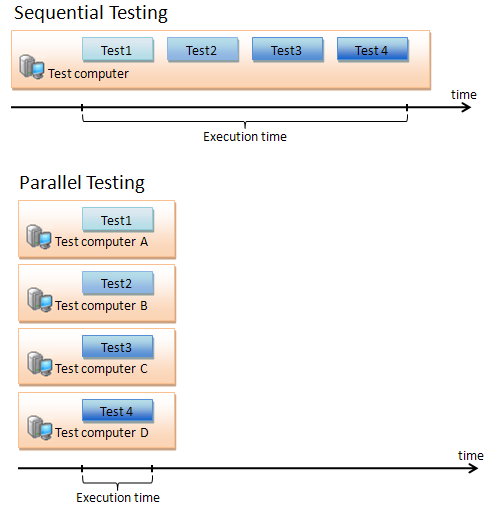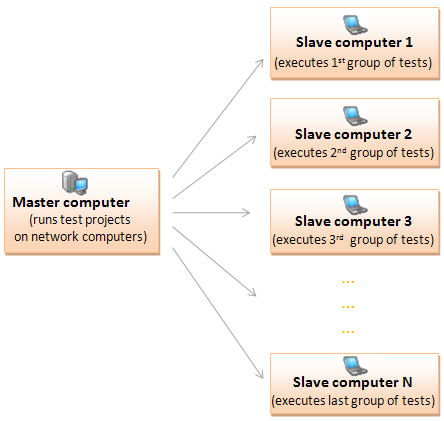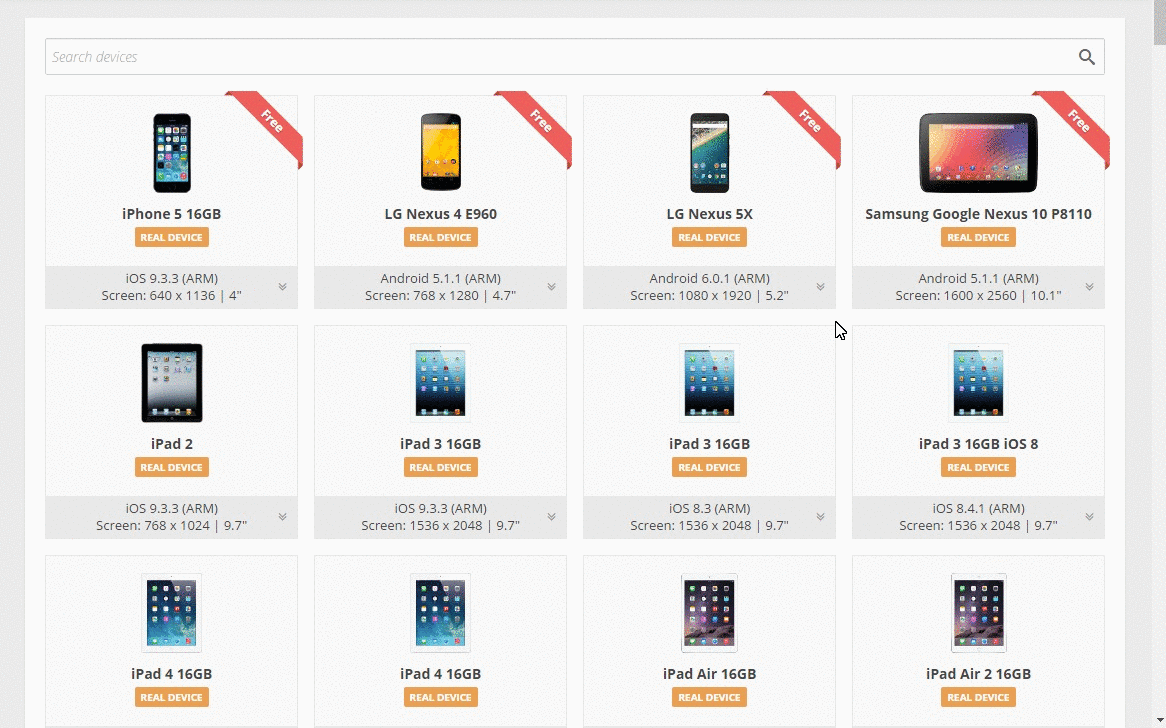Parallel Testing
Parallel testing means testing multiple applications or subcomponents of one application concurrently to reduce the test time. Parallel tests consist of two or more parts (projects or project suites) that check different parts or functional characteristics of an application. These parts are executed on individual computers simultaneously. The ability to test more than one application part "in parallel" allows you to significantly reduce the test time and test your applications more efficiently.

Do not confuse parallel tests with distributed tests. Both of these kinds of tests consist of several parts that are performed on separate computers. However, distributed testing also presupposes that test parts interact with each other during the test run, while the parallel testing approach lacks interaction between test parts.
You can easily perform parallel testing with TestComplete. The general procedure of parallel testing includes the following steps:
- Create individual TestComplete projects that test different parts or functional characteristics of your application.
- Copy the prepared projects to the computers you want to engage in the test.
Note: Each computer participating in parallel tests must have TestComplete or TestExecute installed. TestExecute is a resource-friendly utility that was specially created to run test projects on computers where TestComplete is not installed.
- Start running the projects at once or with an appropriate delay.
To organize parallel testing, you can use the TestComplete network suite. With it, you can easily control the run of several projects on different network computers. You simply create several projects that will test different parts of the application (slave projects) and one project that will run these projects (master project).

The obvious benefit of using the network suite is that you can start running all the tests just by running the master project. Besides that, you can command TestComplete to copy a remote log of the test execution to the master computer making the test results easy to review and analyze.
Are you running the same test manually over and over again on different mobile devices? Are you looking for a way to run manual tests in parallel on multiple mobile devices? Then stop right there. There is actually a solution for this and it’s called test automation. Keep reading to start testing on multiple mobile devices in 3 easy steps.
Note: Interview Questions For Appium Training
1. Start automating all the test cases that can be automated
If you’re new to test automation you should start by choosing a test automation frameworks. If you’re not sure which one to choose, we recommend reading “Mobile Testing Automation Framework – Choose The Right One”.
If you are already using test automation, all of these frameworks, Appium. Robotium and Espresso, support parallel testing on multiple mobile devices.
Tip: If you are planning to test both on Android and iOS, your best choice is Appium, which is the most versatile of the three.
Once you have chosen a mobile testing framework, you should start to write test scripts for your test cases. This guide on “Test Automation Best Practices” will help you decide which test cases are most suited for test automation. If you are haven’t done any automation up to this point, we suggest starting with Appium and our getting started video tutorials.
Are you asking yourself why you should do test automation? We have a list of 10 rock solid reasons – “Top 10 Benefits of Test Automation”!
Here is a practical example of how testing in parallel will help you value your testing time more:
Let’s say you want to test on 5 devices and every test takes 5 minutes. With test automation, it will take 25 minutes to test on all devices. Tests will be run automatically one after another but the test needs to finish on the first device before it can start on the second one, etc. If you test in parallel on multiple mobile devices it will take you just 5 minutes, because the test will be run on all of the 5 devices at the same time.
2. Decide on which devices you want to run your test cases

Once you have your test cases and the scripts for test automation ready, you should decide on which devices to run your tests.
This is a very important step because testing on the right devices and enhancing your app’s quality will help you gain popularity, increase downloads and boost your revenues.
Ideally, you should choose 5 to 10 devices that are relevant to your target market. To find out which devices are the most popular in that market you can use different methods:
- If your app is already published, you can look at the downloads statistics
- If your app is not published yet, you can look at your target market most sold/most used devices. There are different websites that provide these information.
- If you have a web-app you can start by looking at the most popular browsers in your target market.
3. Now it’s time to start parallel testing
This last part is very straightforward:
- Upload your app to TestObject platform
- Upload your test scripts/ test suites
- Choose the devices you want to run your tests on
- Start your test runs and
- Wait for the test report to be ready or use live view to see the test running.
Once the test run is finished, you can look at all the comprehensive results we provide you with such as logs, screenshots, and videos.
If you want to reproduce a particular bug, you can use manual testing.
For More Information Visit Mindmajix
Comments
Post a Comment